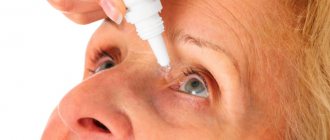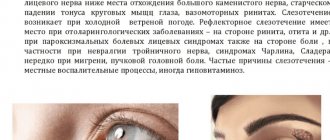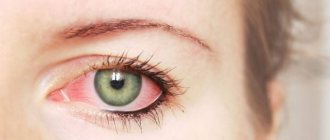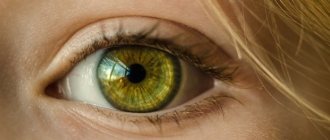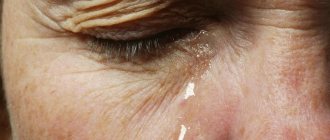Young parents turn to an ophthalmologist when their child’s one eye is watery. Such a symptom should not go unnoticed. It indicates certain disorders in the body. The age of the child and the presence of concomitant diseases are of great importance. If the child is capricious and cries often, then increased tear production can be associated with an unstable emotional state. Although such deviations are also a reason to consult a doctor.
When a child is absolutely calm, but tears flow from one eye, this indicates some disturbances in the functioning of the body. The root cause of this condition is not necessarily ophthalmological. Sometimes similar symptoms appear during acute infections. Together with your doctor, you should choose the optimal tactics of behavior. Some doctors suggest parents observe the child for a while. If after a few days the problem disappears by itself, then you don’t have to worry. If increased tearing remains, this is a reason to undergo a comprehensive full examination of the body.
The reasons for this phenomenon vary in infancy and school age. In infants, a watery eye indicates underdevelopment of the visual system and certain congenital pathologies. If such a symptom appears at an older age, then its root causes are completely different. It is important to identify and eliminate them in a timely manner.
Why are tears needed?
Tear fluid is physiological. It is secreted by the corresponding glands and performs many functions. The main one is cleansing the eyes from dust, dirt, and moisturizing the cornea. The secretion of tears is physiological and emotional in nature. To moisturize the eyeball, a minimal amount of this fluid is released with each blink. If you are overwhelmed by emotions, then tears are actively produced.
“Dry eye” syndrome, when tears are not produced at all, is also a serious pathology, but if a child has only one eye constantly and actively watering, it is worth thinking about his health.
First aid and further treatment
The drug is used to eliminate a viral infection.
If a child’s eyes begin to water while walking outside, then perhaps a grain of sand or speck has entered the child’s eyes and needs to be carefully removed. To alleviate the baby’s condition, it is recommended to rinse the eyesight with plenty of water. If after this there is no relief, then probably the reason for the release of copious amounts of tears lies in a pathological condition. It is recommended to show the child to an ophthalmologist as soon as possible, who will prescribe a comprehensive diagnosis and select the optimal treatment. It is primarily necessary to treat the eyes with medications, which are prescribed taking into account the type and severity of the pathology. The table shows the medications used for increased tearfulness in a child.
| Medication group | Medication |
| Solutions with antiseptic and anti-inflammatory effects | "Furacilin" |
| Antiviral drugs for ARVI | "Interferon" |
| "Imudon" | |
| "Amiksin" | |
| "Acyclovir" | |
| Antipyretics | "Panadol" |
| "Nurofen" | |
| "Ibuprofen" | |
| Antibacterial drugs | "Amoxicillin" |
| "Amoxiclav" | |
| "Cefuroxime" | |
| Eye drops | "Albucid" |
| "Tetracycline" | |
| "Tebrofen" |
Treatment with unconventional methods
Chamomile tea has anti-inflammatory properties.
If your child’s eyes are constantly watering, then you can use folk remedies, which must be previously agreed upon with the doctor. Various herbal decoctions and tinctures, which are used as lotions and compresses on sore organs of vision, are effective for increased lacrimation in childhood. Recipes from healers help when the eyes are watery due to inflammation, overstrain and other disorders. The following folk remedies are used in treatment:
- Rose hip. A healing decoction is prepared from the ingredient, which fights viral infection. Drink the medicine throughout the day until the discomfort disappears.
- Yarrow. The juice of the plant helps to cope with sinusitis, which causes watery eyes in a child. The folk remedy is instilled into the nose, 4 drops each time. Duration of therapy is 10 days.
- Strongly brewed tea or cucumber juice. Such natural medicines are used to wash damaged eyes during an inflammatory reaction in the conjunctiva.
- Chamomile and string. They help a child whose eyes are watery due to allergies. Decoctions prepared from plants are consumed internally.
Causes of increased tearfulness in childhood
If one eye is constantly watering in a baby, this happens for the following reasons:
- Blockage of the nasolacrimal duct;
- Pathological narrowness of the nasolacrimal duct;
- Pathologies of the structure and development of the organs of the visual and respiratory systems.
Tears are needed to moisturize and cleanse the eye. During intrauterine development, the lacrimal glands do not yet work, and the nasolacrimal duct is closed with a special film. After birth, this membrane must rupture to allow tear fluid to drain out. Sometimes this doesn't happen. Tears are released when blinking, but are not released into the nasal cavity. Some of the fluid accumulates under the lower eyelid, causing swelling. Some flows out, causing increased tearing.
This symptom should alert parents. They need to see an ophthalmologist to help them cope with the problem.
Sometimes there is no membrane in the nasolacrimal duct, but it is pathologically narrow. The liquid is only partially removed into the nasal passages, and its excess flows out again. The same thing happens with pathologies of the structure of the organs of the respiratory and visual systems. The earlier such deviations are identified, the easier it is to deal with them. In children of the first year of life, bone and cartilage tissue is still soft and pliable. If surgery on the nasolacrimal duct is required, it should be performed as early as possible. Minimally invasive probing usually helps solve the problem.
School-age children experience other pathologies that cause one eye to become very watery. All these reasons can be divided into ophthalmological and systemic.
Ophthalmic causes
Anomalies of the lacrimal ducts sometimes occur during school or adolescence. Tearfulness provokes conjunctivitis, blepharitis, scleritis, and other inflammatory ailments. Along with tears, pus is also released. Such a symptom is grounds for immediate consultation with a doctor. Most of the above diseases are provoked by dangerous bacteria with low sensitivity to antibiotics.
Only a doctor can select a medicine that will effectively cope with the problem based on a series of tests.
The child's eye may become very watery due to the injury. However, there may be no other visual changes. Only a doctor, after examination using special lamps and microscopes, can draw correct conclusions regarding the reasons for such phenomena.
Tearing is a sign of a foreign body in the eye. It is strictly forbidden to even try to remove it yourself. In this way, you can further injure the eye, cause infection, and cause significant damage to vision. At home, it is only allowed to drip eyes with moisturizing compounds and wipe them with cotton pads moistened with boiled water. If this does not produce results, you will have to consult a doctor.
A sharp decrease in visual acuity sometimes leads to tearing. The child has to strain his eyes a lot to see something. To relax them, an additional volume of tear fluid is released.
Other reasons
Tearfulness is often provoked by infectious processes in the body. A common ARVI can cause such a symptom. If your eye stops watering after complete recovery, you don’t have to worry.
Often, increased secretion of tear fluid indicates severe allergic reactions. In childhood, it is important to promptly identify such a predisposition. An allergist treats the underlying disease. Until the immune system is fully formed, there is a possibility of complete relief from allergies.
A child’s eye may become watery due to serious diseases of the nervous system and oncological processes in the body. If a tumor develops in the brain, it puts pressure on nearby tissues and organs, and the production of tear fluid increases, which is removed in this way. The likelihood of developing such pathologies without other symptoms is minimal, but it exists, so it must be immediately excluded or confirmed with a special examination.
Identifying the cause of watery eyes in a child is an important diagnostic step.
You can't just treat the symptoms, you need to deal with the underlying problem.
What to do if your child's eyes are watery
You need to make sure that this is really regular tearing and not a one-time occurrence. This does not mean that a “lonely” tear should be left on children's eyelashes. You need to carefully remove tears from your eyelashes with a clean napkin or handkerchief.
It is necessary to note whether the appearance of tears recurs or not, and how often it occurs.
Parents should carefully analyze the conditions when their child’s eyes begin to water: on the street, near animals, in the sandbox, etc. This will allow you to determine the causes of lacrimation and, possibly, get rid of it yourself.
For example, when tears appear as a result of an allergy, it is enough to remove the source of the allergy away from the child. If your child gets sand in their eyes, rinsing the eyes can also help clear up any tearing problems.
If parents cannot determine the obvious reasons why their child’s eyes are watery, or initial measures at home do not help for a day or two, they should seek help from a specialist.
An ophthalmologist will conduct an external and detailed examination and, if necessary, use additional methods (biomicroscopy, nasal and tubular tests, endoscopy of the nasal cavity, x-ray of the lacrimal ducts, computed tomogram).
After identifying the “non-emotional” reasons for the child’s tears, the doctor (and only the doctor) will be able to give the necessary recommendations and prescribe the correct treatment.
Well, parents should know the following:
- pathologies of the structure and development of the lacrimal passages and canals are eliminated surgically;
- poor patency of the nasolacrimal ducts is eliminated using a probing procedure;
- removal of a foreign body from the lacrimal canals is carried out only in a medical institution with further appointment of eye rinsing for several days;
- injured tear ducts are restored after taking a course of anti-inflammatory and disinfectant drugs;
- Viral and infectious eye diseases are treated as prescribed by a doctor (drops, ointments, antibiotics).
Associated symptoms
Numerous accompanying symptoms are also important. If the eye waters, and at the same time the child develops a runny nose, cough, or difficulty breathing, this indicates the development of a respiratory disease or an allergic reaction. Such problems are solved by an allergist and pediatrician.
If your vision decreases due to tearing, you need treatment from an ophthalmologist. If neoplasms are detected in the brain, even benign ones, it is worth finding an experienced pediatric oncologist. The following accompanying symptoms are common:
- Headache;
- Sudden mood swings;
- Runny nose, cough, sore throat;
- Change in eye color;
- Pain in the eyes, burning sensation.
Concomitant manifestations of diseases should not be overlooked. You should immediately report them to your doctor so that he can take them into account when making the correct diagnosis.
How can I help my eye?
Listed above are the reasons why a child’s eye is watery. Now let’s figure out how to behave in a given situation, based on the expected diagnosis. I would like to note right away that there are a number of indications for which you should definitely consult a doctor:
- the child is less than a year old;
- photophobia;
- Pain in the eyes;
- the child sees worse;
- bubbles are clearly visible on the skin of the upper eyelid (a sign of herpes conjunctivitis, along with adenoviral conjunctivitis - the most dangerous).
It is also necessary to visit a doctor if self-treatment does not improve within two days.
Infectious conjunctivitis can be caused by viruses or bacteria. It is quite difficult to distinguish one species from another. Therefore, as a rule, ophthalmologists prescribe 2 types of drops for the baby: some act against viruses, others against bacteria. However, modern medicine claims that viral conjunctivitis goes away on its own within a week - during this time the body copes with it on its own. Bacterial conjunctivitis is treated locally with antibiotics. Allergic conjunctivitis is treated with antihistamines, but this only eliminates its symptoms. The main treatment is to find the allergen and eliminate it.
Dacryocystitis is a congenital pathology of the nasolacrimal canal, in which there is a film in it that prevents the passage of tears into the nasopharynx, as a result of which they exit through the eyes. Therefore, constant or episodic lacrimation occurs. If you know what the problem looks like from the inside, it becomes clear why eye drops do not help. So what to do if the cause of lacrimation is dacryocystitis? Before the child reaches 3–8 months of age, the film may rupture on its own without additional therapeutic measures. If this does not happen, then the child will need to have the nasolacrimal canal probed (possibly repeatedly). Mom can stimulate the rupture of the rudimentary film by massaging the lacrimal sac.
Massage of the lacrimal duct
As mentioned above, lacrimation due to ARVI disappears after treatment of the underlying disease. The same can be said about the case when the eye waters on the street due to the presence of an ENT disease of the nose. That is, in these cases, treatment for lacrimation as such is not required.
The eye can become watery when a foreign object gets into it - a speck of dust, specks, eyelashes, midges, etc. If the mother notices something similar in the child’s eye, she should wash her hands, moisten a cotton swab with boiled water at room temperature and gently swipe it several times along the baby's closed eye towards the nose. You cannot “lick” the speck out of your eye and rub it with a dry handkerchief - it must be moistened. If this manipulation does not help, you should consult a doctor.
Rubbing the eyes with tampons soaked in a decoction of chamomile or strong tea alleviates the baby’s condition; in this way, you can wash the eyes from pus, but they do not provide a therapeutic effect. So if a child has a watery eye, the main thing is to find the cause and begin appropriate treatment.
The health of the child from the very moment of birth is under the close attention of parents. Fever, runny nose, cough and teething are frequent companions of a fragile child's body. Each of these phenomena appears for the first time at some point, and caring parents must be prepared for any adversity and at least theoretically know how to help the baby. In this regard, a situation in which a child’s eye waters is indicative. What do watery eyes mean and is this symptom a sign of any disease? It should be sorted out.
If watery eyes in a baby are accompanied by coughing, sneezing and a rise in temperature, it is most obvious that the child has an acute respiratory viral infection, or simply ARVI. Watery eyes in this case are nothing more than one of the “side effects” of a cold. There is no point in treating him directly, because when the baby gets better, the tears will disappear on their own.
Quite often, the cause of tearing in children is allergies. It is not so difficult to determine that the presence of tears was caused by an allergic reaction, because in this case the baby’s eyes not only water, but also itch very much, which is why the baby becomes irritable and nervous. You should not give your child antihistamines yourself, as this can cause even more harm to his body. It is important to show the baby to a doctor as soon as possible, who, after examining the baby, will prescribe adequate treatment.
Conjunctivitis is also one of the likely causes of tears in a child. This disease is characterized not only by watery eyes, but also by swelling of the eyelids, photophobia and redness of the whites of the eyes. In addition, after sleep, purulent contents are also released from the eyes. The cause of conjunctivitis is an infection in the child's eyes. This happens when the baby rubs his eyes with dirty hands or comes into contact with a sick person already infected with this infection. Parents should understand that conjunctivitis is a serious condition that requires immediate treatment. The doctor, after making a diagnosis, must prescribe ointment and eye drops, depending on the origin of the disease, since conjunctivitis can be either allergic, bacterial or viral.
In the case when lacrimation is observed in an infant 2-3 months old, there is a high probability that he has a disease called dacryocystitis. Initially, it is worth saying that babies under two months of age cry without tears, because tear fluid begins to be produced only in the third month of life. This risks the fact that existing defects in the lacrimal ducts may go unnoticed during the first two months of life.
Dacryocystitis is a narrowing of the lacrimal canal, in which the normal function of lacrimation is impaired. The disease leads to obstruction of the lacrimal canal and, ultimately, to its inflammation. Symptoms of dacryocystitis include watery eyes and discharge of pus. Initially, one eye becomes inflamed, but after a few days the pathogenic microflora affects the other. To treat this disease, it is necessary to massage the lacrimal canals 4–6 times a day. In addition, to treat the infection, the baby is prescribed antibiotics in the form of drops for the nose and eyes. If such therapy does not give the expected effect, the problem is solved surgically.
In any case, if you notice that your baby’s eyes are watery and festering, you should not ignore it. It is better to visit a doctor as soon as possible and tell him about the observed symptoms, as well as about the baby’s allergies. In addition, it is necessary to ensure that the child rubs his eyes only with clean hands. For their part, adults should remove purulent contents and tears using a sterile cotton swab.
As an auxiliary therapy, you can help your child by washing his eyes with chamomile infusion, tea or furatsilin solution. Take care of your kids!
Babies cry without tears for the first two months of life. This is due to the fact that tear fluid begins to be produced only in the second or third month of life. This is why some congenital defects of the lacrimal ducts may go unnoticed in the first months of a child’s life.
The main part of all tear fluid is produced by the lacrimal gland, located in the depths of the orbit near the outer third of the upper eyelid; a small amount of tear fluid is produced by small lacrimal glands located deep in the conjunctiva. In a healthy eye, the tear fluid enters the conjunctival cavity, where, with the help of blinking movements of the eyelids, it is distributed evenly over the surface of the eyeball and collected at the inner corner of the eye, from where, through the lower and upper lacrimal openings, the tear enters the lacrimal canaliculi, which flow into the lacrimal sac. The nasolacrimal duct originates from the lacrimal sac, which drains tears into the nasal cavity. Lacrimal puncta are located at the top of peculiar elevations on the so-called lacrimal papillae, which face the eyeball. The outlet of the nasolacrimal duct in newborns is closed by a delicate film, which normally ruptures at birth.
Diagnostic measures
If the eye is watery for ophthalmological reasons, diagnosis is carried out by an ophthalmologist. First, the eye and eyelids are examined. For a more detailed examination, a slit lamp and a special microscope are used. X-ray examination of the nasolacrimal ducts gives good results. If there is a suspicion of serious brain pathologies, an MRI or CT scan is prescribed.
The diagnostic results are known immediately. Based on them, the doctor makes conclusions regarding the final diagnosis. After this, a scheme for further treatment is determined depending on the stage of the disease, its location, the patient’s age, and the presence of concomitant ailments. Only a doctor can draw correct conclusions regarding the child’s health condition and make a forecast of the effectiveness of the upcoming treatment.
It is necessary to follow all the specialist’s recommendations to get rid of the existing problem. Treatment should not be stopped prematurely, even if all symptoms have disappeared. They may return again, and those drugs that were used previously will no longer be so effective.
If the eye is red and swollen
If the eye is not just red, but also swollen, then the reason for this may be:
- Excessive consumption of salt, alcohol. To eliminate redness and swelling of the eyes in this case, you should limit the consumption of salty or alcoholic foods. A cold tea compress will help relieve swelling faster. To do this, soak a cotton swab in cold tea and apply it to your eyes. But in most cases, swelling of the eyes caused by the abuse of the above products, with healthy kidneys, goes away within a day.
- High pressure. With high blood pressure, the eyes may also become red and swollen, in which case only a doctor can prescribe an antihypertensive drug.
- Pregnancy. Some pregnant women experience redness and swelling of the eyes. It is recommended not to get too carried away with drinks, but to replace them with water, since pregnancy already puts a lot of stress on the kidneys.
- The eye may also become red and swollen due to an allergic reaction, for example to an insect bite. In this case, depending on your age dosage, take one of these drugs: Zyrtec, Fenistil, Loratodine or Suprastin.
- If the lower eyelid of the eye is swollen and painful, then the reason for this may be either some low-quality cosmetic product, problems in the field of gynecology, or simply fatigue. This problem occurs most often in women. But there are cases when swelling and redness of the eye in the lower eyelid is the result of excessive growth of adipose tissue. Only surgery can correct this problem. If the upper eyelid is swollen, you should look for the cause in an insect bite or stye.
If your eyes regularly become red and swollen, you should definitely undergo an examination at the hospital to identify the cause. After all, redness and swelling in most cases are very important symptoms of problems in your body. In frequent cases of stye appearing on the eye, we can talk about reduced immunity or vitamin deficiency.
Choice of treatment methods
The treatment method is selected based on the specific diagnosis. If the cause of tearing is overstrain of the organs of vision, dryness of the eyeball, moisturizing compounds and some antiseptics are prescribed. The action of the latter is aimed at reducing the likelihood of developing inflammatory processes.
Conjunctivitis is treated with antibacterial drops and ointments.
Sometimes such drugs are prescribed internally. For allergies, antihistamines are prescribed to relieve unpleasant symptoms, but to completely get rid of such attacks, long-term complex treatment is prescribed.
If the nasolacrimal duct is blocked or abnormally narrow, emergency surgery may be required. This intervention is minimally invasive, but in childhood it is performed under general anesthesia. In infancy, you can get rid of this problem with the help of a long massage, which is performed using a special technique. An ophthalmologist will tell you about this, and he will also show you what movements and with what force you need to perform.
If a child has a watery eye, the problem cannot be dismissed; it must be eliminated. Be sure to listen to all recommendations from your doctor. If he refers you to another specialist, do not resist. Parents bear full responsibility for the health of their children, so it is in their interests to receive competent professional medical care.
Causes
The sooner parents find out why their child's eyes are watering, the sooner they can take appropriate action. After all, competent treatment will largely depend on the causes of this phenomenon. It can be:
- abnormalities of the lacrimal canals: their elongation, change in shape, protrusion (medical name - diverticula), inflammation (the diagnosis will include canaliculitis);
- if one eye is watery, a violation of the outflow of fluid may be caused by a foreign body entering the canal (this could be an eyelash, a speck of dust, dirt);
- cysts, tumors - malignant (squamous cell carcinoma, basal cell carcinoma), benign (papillomas, polyps);
- traumatic damage to the canals, which often leads to their change, narrowing and subsequent fusion - this can occur due to careless washing or probing of the lacrimal ducts during repeated therapeutic and preventive procedures;
- if a child’s eye is watery and purulent, it may be diseases such as conjunctivitis (which is often a consequence of influenza or common ARVI), blepharitis, keratitis, scleritis, dacryocystitis, inflammation of the paranasal sinuses and nasal cavity;
- if at the same time a child sneezes and his eyes water (they can also become very red, and sometimes babies want to scratch them because of the itching), this is a manifestation of an allergy;
- malignant formations of the pituitary gland, paranasal sinuses;
- some pathologies of the nervous system explain why one eye is watery, and not both;
- a temperature difference (if the baby goes from warm to cold) causes a protective reaction in the eyes: in such cases, under normal conditions this does not happen, is not a pathology and does not require treatment.
All these factors can cause excessive tearing in children 1–2 years of age and older. But if an infant’s eye waters at 2–6 months, the causes of this phenomenon are most often various tear drainage disorders:
- the nasolacrimal duct is closed by the embryonic film;
- the structure and location of the nasolacrimal duct is disturbed;
- pathology of lacrimal openings and canals, eyelids;
- the lacrimal sac has abnormalities in development or location;
- the nose has anomalies in the development of its structure;
- there are pathologies of the nasal or eye mucosa;
- various injuries (mechanical) of the lacrimal ducts.
Too long lacrimation, which is not stopped by anything, entails a change in the microflora, which further provokes the occurrence of inflammation. To avoid complications, you need to know what to do if a child has a watery eye: first, he should be taken for examination by an ophthalmologist, who will give the necessary recommendations and, if necessary, prescribe appropriate treatment.
Possible complications
When a child’s eyes water due to a pathological phenomenon and the patient does not receive prompt medical attention, negative consequences are likely. If unpleasant symptoms appear due to allergies, severe reactions that threaten the child’s life are possible. Also, increased tearfulness causes bronchial asthma and hemolytic anemia, against which anemia develops. When the eyes water for a long time, an inflammatory process in the ear is possible, which is why the child becomes hard of hearing. There are also frequent disorders of the skin, resulting in the development of dermatitis, psoriasis and eczema.
